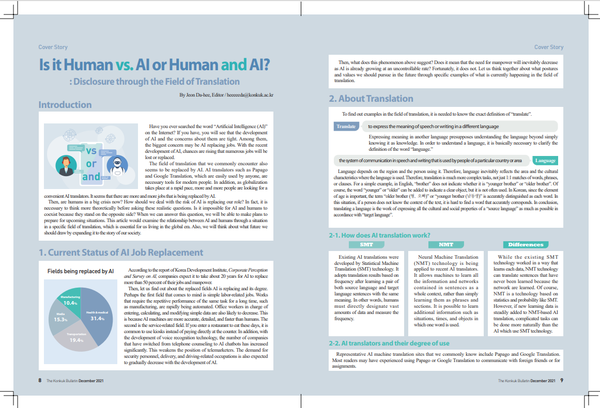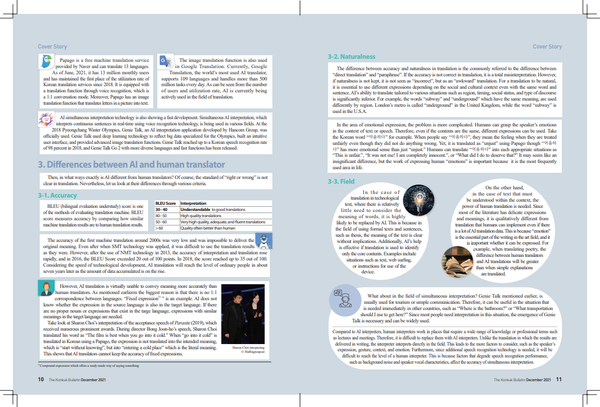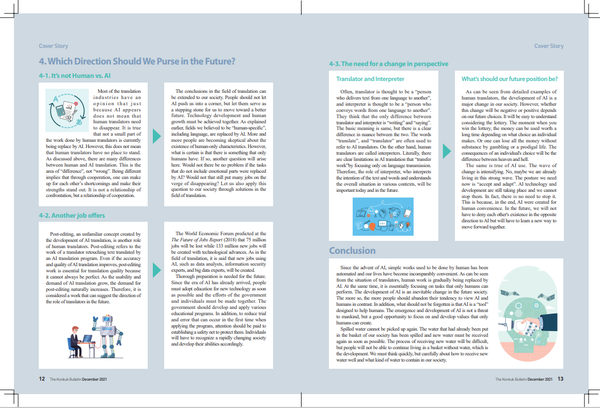: Disclosure through the Field of Translation



Introduction
Have you ever searched the word “Artifi cial Intelligence (AI)” on the Internet? If you have, you will see that the development of AI and the concerns about them are tight. Among them, the biggest concern may be AI replacing jobs. With the recent development of AI, chances are rising that numerous jobs will be lost or replaced. The field of translation that we commonly encounter also seems to be replaced by AI. AI translators such as Papago and Google Translation, which are easily used by anyone, are necessary tools for modern people. In addition, as globalization takes place at a rapid pace, more and more people are looking for a convenient AI translators. It seems that there are more and more jobs that is being replaced by AI.
Then, are humans in a big crisis now? How should we deal with the risk of AI is replacing our role? In fact, it is necessary to think more theoretically before asking these realistic questions. Is it impossible for AI and humans to coexist because they stand on the opposite side? When we can answer this question, we will be able to make plans to prepare for upcoming situations. This article would examine the relationship between AI and humans through a situation in a specific field of translation, which is essential for us living in the global era. Also, we will think about what future we should draw by expanding it to the story of our society.
1. Current Status of AI Job Replacement
According to the report of Korea Development Institute, Corporate Perception and Survey on AI, companies expect it to take about 20 years for AI to replace more than 50 percent of their jobs and manpower. Then, let us find out about the replaced fields AI is replacing and its degree. Perhaps the first field that comes to mind is simple labor-related jobs. Works that require the repetitive performance of the same task for a long time, such as manufacturing, are rapidly being automated. Office workers in charge of entering, calculating, and modifying simple data are also likely to decrease. This is because AI machines are more accurate, detailed, and faster than humans. The second is the service-related field. If you enter a restaurant to eat these days, it is common to use kiosks instead of paying directly at the counter. In addition, with the development of voice recognition technology, the number of companies that have switched from telephone counseling to AI chatbots has increased significantly. This weakens the position of telemarketers. The demand for security personnel, delivery, and driving-related occupations is also expected to gradually decrease with the development of AI.
Then, what does this phenomenon above suggest? Does it mean that the need for manpower will inevitably decrease as AI is already growing at an uncontrollable rate? Fortunately, it does not. Let us think together about what postures and values we should pursue in the future through specifi c examples of what is currently happening in the fi eld of translation.
2. About Translation
To find out examples in the fi eld of translation, it is needed to know the exact defi nition of “translate”.
Translate: to express the meaning of speech or writing in a different language
Expressing meaning in another language presupposes understanding the language beyond simply knowing it as knowledge. In order to understand a language, it is basically necessary to clarify the defi nition of the word “language.”
Language: the system of communication in speech and writing that is used by people of a particular country or area
Language depends on the region and the person using it. Therefore, language inevitably reflects the area and the cultural characteristics where the language is used. Therefore, translation is much more complex tasks, not just 1:1 matches of words, phrases, or clauses. For a simple example, in English, “brother” does not indicate whether it is “younger brother” or “older brother”. Of course, the word “younger” or “older” can be added to indicate a clear object, but it is not often used. In Korean, since the element of age is important, the term “older brother (형, 오빠)” or “younger brother (남동생)” is accurately distinguished as each word. In this situation, if a person does not know the context of the text, it is hard to find a word that accurately corresponds. In conclusion, translating a language is the work of expressing all the cultural and social properties of a “source language” as much as possible in accordance with “target language”.
2-1. How does AI translation work?
SMT: Existing AI translations were developed by Statistical Machine Translation (SMT) technology. It adopts translation results based on frequency after learning a pair of both source language and target language sentences with the same meaning. In other words, humans must directly designate vast amounts of data and measure the frequency.
NMT: Neural Machine Translation (NMT) technology is being applied to recent AI translators. It allows machines to learn all the information and networks contained in sentences as a whole context, rather than simply learning them as phrases and sections. It is possible to learn additional information such as situations, times, and objects in which one word is used.
DIFFERENCE: While the existing SMT technology worked in a way that learns each data, NMT technology can translate sentences that have never been learned because the network are learned. Of course, NMT is a technology based on statistics and probability like SMT. However, if new learning data is steadily added to NMT-based AI translation, complicated tasks can be done more naturally than the AI which use SMT technology.
2-2. AI translators and their degree of use
Representative AI machine translation sites that we commonly know include Papago and Google Translation. Most readers may have experienced using Papago or Google Translation to communicate with foreign friends or for assignments.
Papago is a free machine translation service provided by Naver and can translate 13 languages. As of June, 2021, it has 13 million monthly users and has maintained the first place of the utilization rate of Korean translation services since 2018. It is equipped with a translation function through voice recognition, which is a 1:1 conversation mode. Moreover, Papago has an image translation function that translates letters in a picture into text.
The image translation function is also used in Google Translation. Currently, Google Translation, the world’s most used AI translator, supports 109 languages and handles more than 500 million tasks every day. As can be seen from the number of users and utilization rate, AI is currently being actively used in the fi eld of translation.
AI simultaneous interpretation technology is also showing a fast development. Simultaneous AI interpretation, which interprets continuous sentences in real-time using voice recognition technology, is being used in various fi elds. At the 2018 Pyeongchang Winter Olympics, Genie Talk, an AI interpretation application developed by Hancom Group, was offi cially used. Genie Talk used deep learning technology to refl ect big data specialized for the Olympics, built an intuitive user interface, and provided advanced image translation functions. Genie Talk reached up to a Korean speech recognition rate of 98 percent in 2018, and Genie Talk Go 2 with more diverse languages and fast functions has been released.
3. Differences between AI and human translator
Then, in what ways exactly is AI diff erent from human translators? Of course, the standard of “right or wrong” is not clear in translation. Nevertheless, let us look at their diff erences through various criteria.
3-1. Accuracy
BLEU (bilingual evaluation understudy) score is one of the methods of evaluating translation machine. BLEU score measures accuracy by comparing how similar machine translation results are to human translation results.
The accuracy of the fi rst machine translation around 2000s was very low and was impossible to deliver the original meaning. Even after when SMT technology was applied, it was diffi cult to use the translation results as they were. However, after the use of NMT technology in 2013, the accuracy of interpretation and translation rose rapidly, and in 2016, the BLEU Score exceeded 20 out of 100 points. In 2018, the score reached up to 35 out of 100. Considering the speed of technological development, AI translation will reach the level of ordinary people in about seven years later as the amount of data accumulated is on the rise.
However, AI translation is virtually unable to convey meaning more accurately than human translators. As mentioned earlierm the biggest reason is that there is no 1:1 correspondence between languages. “Fixed expression1) ” is an example. AI does not know whether the expression in the source language is also in the target language. If there are no proper nouns or expressions that exist in the targe language, expressions with similar meanings in the target language are needed.
Take look at Sharon Choi’s interpretation of the acceptance speech of Parasite (2019), which received numerous prominent awards. During director Bong Joon-ho’s speech, Sharon Choi translated his word as “The film is best when you go into it cold.” When “go into it cold” is translated in Korean using a Papago, the expression is not translated into the intended meaning, which is “start without knowing”, but into “entering a cold place” which is the literal meaning. This shows that AI translators cannot keep the accuracy of fi xed expressions.
3-2. Naturalness
The difference between accuracy and naturalness in translation is the commonly referred to the diff erence between “direct translation” and “paraphrase”. If the accuracy is not correct in translation, it is a total misinterpretation. However, if naturalness is not kept, it is not seen as “incorrect”, but as an “awkward” translation. For a translation to be natural, it is essential to use diff erent expressions depending on the social and cultural context even with the same word and sentence. AI’s ability to translate tailored to various situations such as region, timing, social status, and type of discourse is signifi cantly inferior. For example, the words “subway” and “underground” which have the same meaning, are used diff erently by region. London’s metro is called “underground” in the United Kingdom, while the word “subway” is used in the U.S.A.
In the area of emotional expression, the problem is more complicated. Humans can grasp the speaker’s emotions in the context of text or speech. Therefore, even if the contents are the same, diff erent expressions can be used. Take the Korean word “억울하다” for example. When people say “억울하다”, they mean the feeling when they are treated unfairly even though they did not do anything wrong. Yet, it is translated as “unjust” using Papago though “억울하 다” has more emotional sense than just “unjust.” Humans can translate “억울하다” into each appropriate situations as “This is unfair.”, “It was not me! I am completely innocent.”, or “What did I do to deserve that?” It may seem like an insignifi cant diff erence, but the work of expressing human “emotions” is important because it is the most frequently used area in life.
3-3. Field
In the case of translation in technological text, where there is relatively little need to consider the meaning of words, it is highly likely to be replaced by AI. This is because in the field of using formal texts and sentences, such as thesis, the meaning of the text is clear without implications. Additionally, AI’s help is eff ective if translation is used to identify only the core contents. Examples include situations such as text, web surfing, or instructions for use of the device.
On the other hand, in the case of text that must be understood within the context, the power of human translation is needed. Since most of the literature has delicate expressions and meanings, it is qualitatively different from translation that humans can implement even if there is a lot of AI translation data. This is because “emotion” is the essential part of the writing in the art field, and it is important whether it can be expressed. For example, when translating poetry, the difference between human translators and AI translations will be greater than when simple explanations are translated.
What about in the field of simultaneous interpretation? Genie Talk mentioned earlier, is usually used for tourism or simple communication. Therefore, it can be useful in the situation that is needed immediately in other countries, such as “Where is the bathroom?” or “What transportation should I use to get here?” Since most people need interpretation in this situation, the emergence of Genie Talk is necessary and can be widely used.
Compared to AI interpreters, human interpreters work in places that require a wide range of knowledge or professional terms such as lectures and meetings. Therefore, it is difficult to replace them with AI interpreters. Unlike the translation in which the results are delivered in writing, the interpreter interprets directly in the fi eld. This leads to the more factors to consider, such as the speaker’s expression, gesture, context, and emotion. Furthermore, since additional speech recognition technology is needed, it will be difficult to reach the level of a human interpreter. This is because factors that degrade speech recognition performance, such as background noise and speaker vocal characteristics, aff ect the accuracy of simultaneous interpretation.
4. Which Direction Should We Purse in the Future?
4-1. It’s not Human vs. AI
Most of the translation industries have an o p i n i o n t h a t j u s t because AI appears does not mean that human translators need to disappear. It is true that not a small part of the work done by human translators is currently being replace by AI. However, this does not mean that human translators have no place to stand. As discussed above, there are many differences between human and AI translation. This is the area of “diff erence”, not “wrong”. Being diff erent implies that through cooperation, one can make up for each other’s shortcomings and make their strengths stand out. It is not a relationship of confrontation, but a relationship of cooperation.
The conclusions in the field of translation can be extended to our society. People should not let AI push us into a corner, but let them serve as a stepping stone for us to move toward a better future. Technology development and human growth must be achieved together. As explained earlier, fi elds we believed to be “human-specifi c”, including language, are replaced by AI. More and more people are becoming skeptical about the existence of human-only characteristics. However, what is certain is that there is something that only humans have. If so, another question will arise here. Would not there be no problem if the tasks that do not include emotional parts were replaced by AI? Would not that still put many jobs on the verge of disappearing? Let us also apply this question to our society through solutions in the fi eld of translation.
4-2. Another job offers
Post-editing, an unfamiliar concept created by the development of AI translation, is another role of human translators. Post-editing refers to the work of a translator retouching text translated by an AI translation program. Even if the accuracy and quality of AI translation improves, post-editing work is essential for translation quality because it cannot always be perfect. As the usability and demand of AI translation grow, the demand for post-editing naturally increases. Therefore, it is considered a work that can suggest the direction of the role of translators in the future.
The World Economic Forum predicted at the The Future of Jobs Report (2018) that 75 million jobs will be lost while 133 million new jobs will be created with technological advances. As in the field of translation, it is said that new jobs using AI, such as data analysts, information security experts, and big data experts, will be created. Thorough preparation is needed for the future. Since the era of AI has already arrived, people must adopt education for new technology as soon as possible and the efforts of the government and individuals must be made together. The government should develop and apply various educational programs. In addition, to reduce trial and error that can occur in the first time when applying the program, attention should be paid to establishing a safety net to protect them. Individuals will have to recognize a rapidly changing society and develop their abilities accordingly.
4-3. The need for a change in perspective
Translator and Interpreter
Often, translator is thought to be a “person who delivers text from one language to another”, and interpreter is thought to be a “person who conveys words from one language to another”. They think that the only difference between translator and interpreter is “writing” and “saying”. The basic meaning is same, but there is a clear diff erence in nuance between the two. The words “translate”, and “translator” are often used to refer to AI translators. On the other hand, human translators are called interpreters. Literally, there are clear limitations in AI translation that “transfer work”by focusing only on language transmission. Therefore, the role of interpreter, who interprets the intention of the text and words and understands the overall situation in various contexts, will be important today and in the future.
What’s should our future position be?
As can be seen from detailed examples of human translators, the development of AI is a major change in our society. However, whether this change will be negative or positive depends on our future choices. It will be easy to understand considering the lottery. The moment when you win the lottery, the money can be used worth a long time depending on what choice an individual makes. Or one can lose all the money without substance by gambling or a prodigal life. The consequences of an individual's choice will be the diff erence between heaven and hell.
The same is true of AI use. The wave of change is intensifying. No, maybe we are already living in this strong wave. The posture we need now is “accept and adapt”. AI technology and development are still taking place and we cannot stop them. In fact, there is no need to stop it. This is because, in the end, AI were created for human convenience. In the future, we will not have to deny each other's existence in the opposite direction to AI but will have to learn a new way to move forward together.
Conclusion
Since the advent of AI, simple works used to be done by human has been automated and our lives have become incomparably convenient. As can be seen from the situation of translators, human work is gradually being replaced by AI. At the same time, it is essentially focusing on tasks that only humans can perform. The development of AI is an inevitable change in the future society. The more so, the more people should abandon their tendency to view AI and humans in contrast. In addition, what should not be forgotten is that AI is a “tool” designed to help humans. The emergence and development of AI is not a threat to mankind, but a good opportunity to focus on and develop values that only humans can create.
Spilled water cannot be picked up again. The water that had already been put in the basket of our society has been spilled and new water must be received again as soon as possible. The process of receiving new water will be diffi cult, but people will not be able to continue living in a basket without water, which is the development. We must think quickly, but carefully about how to receive new water well and what kind of water to contain in our society.
By Jeon Da-hee, Editor / heeeeeda@konkuk.ac.kr

